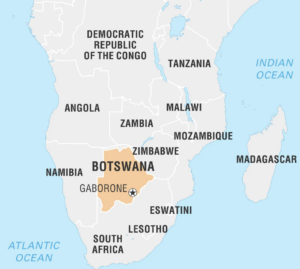24 August 2024 : Daily Current Affairs
1. India Denies Role in Bangladesh Floods, Clarifies No Water Release from Tripura Dam
- 1. India Denies Role in Bangladesh Floods, Clarifies No Water Release from Tripura Dam
- 2. Not neutral, India on the side of peace, says Modi in Ukraine
- 3. President of India graces first National Space Day Celebration
- PRELIMS FACTS
- 1. Modi’s Historic Train Journey to Kyiv Highlights Ukraine’s ‘Rail Force One’ Diplomacy
- 2. ISRO Finalizes Chandrayaan-4 Mission for 2027: Aims to Bring Lunar Samples Back to Earth
- 3. ‘Space sector contributed ₹20,000 crore to India’s GDP over the last decade’
- 4. Botswana discovers the world’s second largest diamond
(Source: Indian Express; Section: Explained; Page: 19)
| Topic: GS2 – International Relations GS1 – Geography |
| Context: |
| The Ministry of External Affairs (MEA) of India clarified that the recent floods in eastern Bangladesh were not caused by the release of water from the Dumbur dam in Tripura, as some social media accounts had claimed. |
Analysis of News:
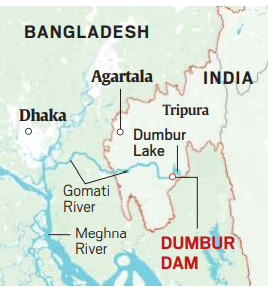
Impact of Floods in Bangladesh
- Nearly 1.8 million people across 43 upazilas in Bangladesh were affected by the floods, especially in districts bordering Tripura.
Rumors and Official Denial
- Unverified social media claims suggested that India had released water from the Gumti hydro-electric project, leading to floods in Bangladesh.
- Tripura’s Power Minister, Ratan Lal Nath, clarified that no floodgates were opened. Instead, excess water automatically escaped the reservoir due to heavy rainfall.
- The MEA reiterated that the claims regarding the Dumbur dam were factually incorrect, attributing the floods to heavy rains in the catchment areas downstream of the dam.
Dumbur Dam and River Systems
- The Dumbur dam is located more than 120 km upstream of the India-Bangladesh border and is not responsible for the floods.
- The Gumti River, formed by the Raima and Sarma rivers, is Tripura’s most significant river and continues to flow above the danger mark due to heavy rainfall.
Gumti river:
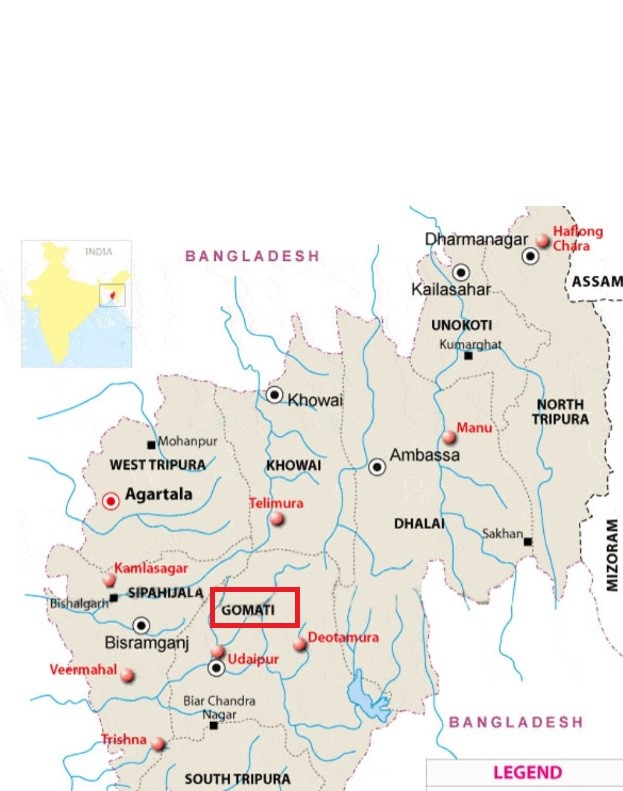
- Source– Dumur, Tripura
- Mouth– Meghna River
- The Gumti, Gomti, Gumati or Gomati is a river flowing through the north-eastern Indian state of Tripura and the district of Comilla in Bangladesh.
- A dam has been constructed near Dumbur on the river that has formed a 40 square kilometres (15 sq mi) lake.
Heavy Rainfall in Tripura
- South Tripura district received 288.8 mm of rain in a single day on August 19, while Agartala recorded 233 mm in 24 hours.
- The heavy rain caused severe flooding, with at least 24 people feared dead and 1.28 lakh people sheltered in relief camps since August 19.
| Key facts related to the Dumbur dam |
|
| Practice Question: Discuss the role of misinformation in international relations, with reference to the recent allegations surrounding the release of water from the Dumbur dam in Tripura and its impact on India-Bangladesh relations. How can such situations be effectively managed through diplomatic channels? (250 words/15 m) |
2. Not neutral, India on the side of peace, says Modi in Ukraine
(Source – The Hindu, International Edition – Page No. – 1)
| Topic: GS2 – International Relations |
| Context |
|

Advancements in India-Ukraine Relations during Prime Minister Modi’s Recent Visit:
- Historic Visit: This was the first visit by an Indian Prime Minister to Ukraine since its independence in 1991.
- Peace Efforts: Prime Minister Modi emphasised9 India’s commitment to supporting peace efforts, underlining India’s stance on the need for dialogue and diplomacy to resolve the Russia-Ukraine conflict.
- Humanitarian Focus: Four key agreements were signed, focusing on:
- Humanitarian assistance by India for high-capacity development projects.
- Cooperation in agriculture and the food industry.
- Cultural cooperation.
- Agreement on drug quality and regulation.
- Support for Sovereignty: PM Modi reaffirmed India’s respect for the sovereignty and territorial integrity of nations, stressing that India has chosen the “side of peace” from the start of the conflict.
- Ukraine’s Concerns: Ukrainian President Volodymyr Zelenskyy raised concerns about India’s purchase of Russian oil, highlighting India’s influence on Russia’s economy.
| How can India mediate between Russia – Ukraine conflict? |
|
Ways for India to Mediate Between Russia and Ukraine
Potential Implications for India
|
| Practice Question: Evaluate how India can leverage its diplomatic position to mediate between Russia and Ukraine in the ongoing conflict. Discuss the potential strategies and challenges involved in India’s mediation efforts. (150 Words /10 marks) |
3. President of India graces first National Space Day Celebration
(Source – https://pib.gov.in/PressReleseDetail.aspx?PRID=2048035 )
| Topic: GS3 – Science and Technology |
| Context |
|

First 3D printed Semi-Cryogenicengine
Key Innovations/Steps Highlighted By The President:
- 3D Printed Semi-Cryogenic Engine: An Indian company successfully launched a rocket powered by a single-piece 3D printed semi-cryogenic engine. This innovation reduces production time and costs while enhancing precision and efficiency in engine design.
- ISRO System for Safe & Sustainable Operations Management (IS4OM): The IS4OM facility ensures the safe and sustainable operation of space missions by monitoring space debris and protecting Indian satellites. ISRO is working towards making all its space missions debris-free by 2030.
- Private Sector Involvement in Space: The space sector’s opening to private companies has led to a rapid increase in startups. This has spurred innovation and provided new opportunities for the youth to contribute to space research.
- Technological Advancements Impacting Various Sectors: Developments in space exploration have benefited industries such as healthcare, transportation, security, energy, and IT, transforming human life and accelerating scientific progress.
| National Space Day: |
|
PRELIMS FACTS
1. Modi’s Historic Train Journey to Kyiv Highlights Ukraine’s ‘Rail Force One’ Diplomacy
(Source: Indian Express; Section: Explained; Page: 19)
| Context: |
|
Analysis of News:
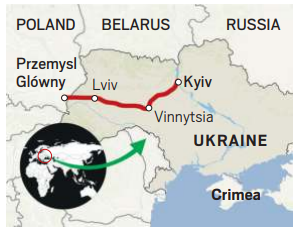
The Train to Kyiv:
- Operated by Ukrainian Railways, the train is adorned in Ukraine’s national colors, blue and yellow, and features luxury compartments with modern amenities.
- The journey from Przemysl Glówny station in Poland to Kyiv spans 700 kilometers and takes approximately 10 hours.
Notable Passengers:
- The train has carried several prominent global leaders, including the Prime Ministers of Poland, Slovenia, and the Czech Republic, as well as other dignitaries like Boris Johnson, Emmanuel Macron, and Justin Trudeau.
‘Iron Diplomacy’:
- Ukraine’s Strategic Industries Minister, Alexander Kamyshin, has coined the term “#IronDiplomacy” to describe these diplomatic train trips.
- The railway network plays a crucial role in Ukraine’s war efforts, aiding in the transportation of aid and people across the country.
2. ISRO Finalizes Chandrayaan-4 Mission for 2027: Aims to Bring Lunar Samples Back to Earth
(Source: Indian Express; Section: Express Network; Page: 11)
| Context: |
|
Analysis of News:
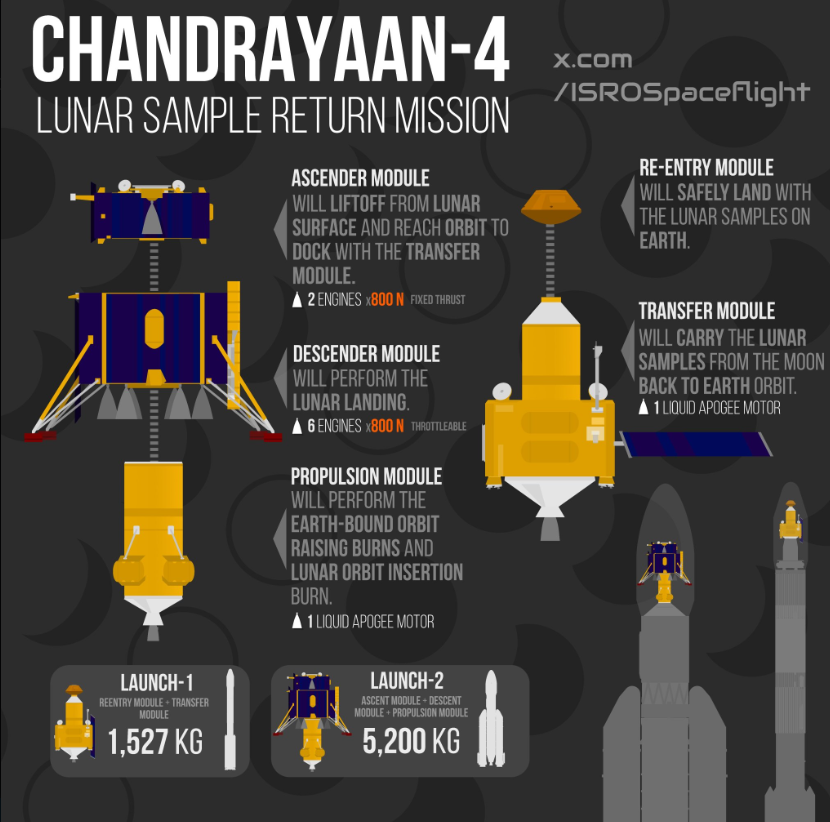
Mission Structure
- Modules: The Chandrayaan-4 spacecraft will consist of five separate modules, unlike Chandrayaan-3, which had three. The mission involves complex stages, including landing, sample collection, and returning the samples to Earth.
- Docking Operations: The mission will require docking space modules twice—a new capability for ISRO that will be first demonstrated in the upcoming Spadex mission.
Technological Advancements
- Previous Demonstrations: Key capabilities, such as lifting off from the lunar surface and bringing a spacecraft back from lunar orbit, were successfully demonstrated during Chandrayaan-3. This sets the foundation for the Chandrayaan-4 mission.
Scientific Importance
- Sample Return: Bringing lunar samples back to Earth will enable more detailed analysis with advanced instruments, facilitating significant scientific discoveries. The samples will be distributed across various scientific laboratories in India.
3. ‘Space sector contributed ₹20,000 crore to India’s GDP over the last decade’
(Source – The Hindu, International Edition – Page No. – 5)
| Context |
|
Analysis of the news:
- India’s space sector contributed approximately $24 billion (₹20,000 crore) to its GDP over the past decade.
- The sector directly supported 96,000 jobs in both public and private sectors.
- For every dollar produced by the space sector, there was a multiplier effect of $2.54 in the Indian economy.
- India’s space workforce was found to be 2.5 times more productive than the broader industrial workforce.
- The findings and report was initiated by ISRO and conducted by econONE and Novaspace.
- The report evaluated the socio-economic impact of the space sector from 2014 to 2023.
4. Botswana discovers the world’s second largest diamond
(Source – The Hindu, International Edition – Page No. – 13)
| Context |
|
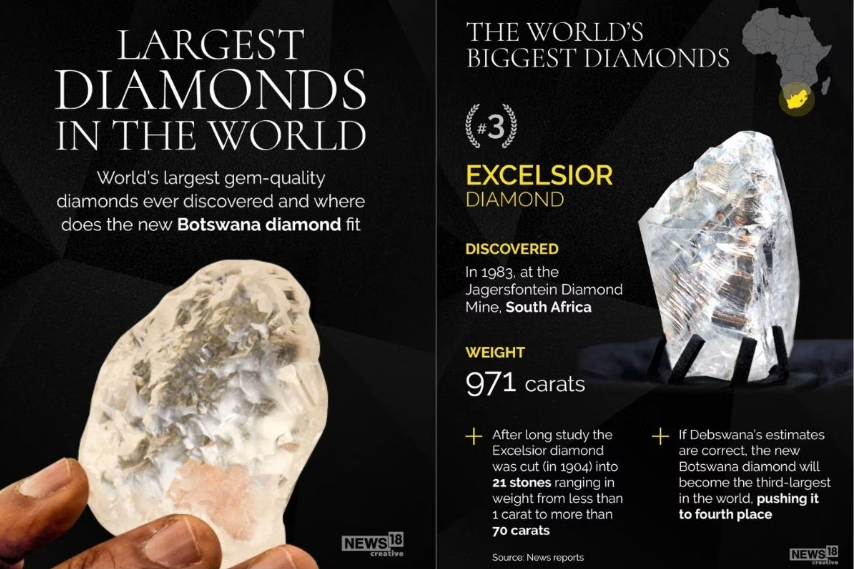
Analysis of the news:
- A 2,492-carat diamond, the second largest in the world, was discovered in Botswana’s Karowe Diamond Mine.
- The diamond was found using X-ray detection technology developed by Lucara Diamond Corp.
| X-ray Detection Technology |
|
- It is second in size only to the 3,016-carat Cullinan Diamond found in South Africa in 1905.
- The diamond was presented to Botswana’s President Mokgweetsi Masisi by Lucara’s managing director.
- Botswana is a leading global producer of diamonds, and this discovery is the largest ever found in the country.
